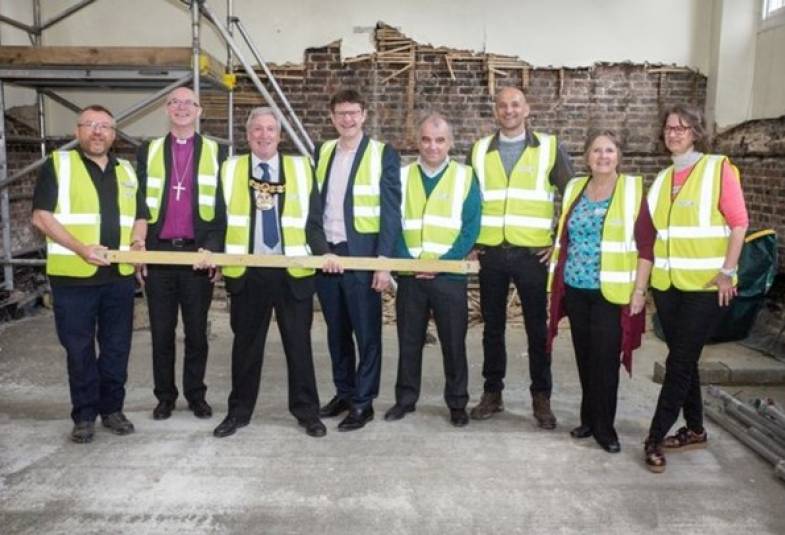16/02/2021
This blog is written by a member of the independent Commission. These views do not necessarily represent the views of the Archbishops' or the Church of England.

Rob Marsh, CEO West Kent YMCA, the Right Reverend James Langstaff, Bishop of Rochester, Cllr David Neve, then Mayor of Tunbridge Wells, Greg Clarke, MP for Tunbridge Wells, Gareth Hepwrtoh, CEO of Habitat for Humanity Homes, Tony Parsons, Habitat for Humanity Homes Construction Manager, Sue Hall and Alison Ruff, West Kent Quakers.
Get in early. Don’t wait until something needs to be done.
The Friends’ Meeting House where the Quakers met was not in a critical condition, but they knew that it was a risk. The building was considerably larger than they needed, and if anything happened to the building it could threaten their existence. They decided to work out how to fix this problem before it got too late. Gareth Hepworth, who worked with them on behalf of the charity Habitat for Humanity GB Homes, believes that this was key to the success of the changes – their decisions weren’t skewed by time pressures and panic.
Spend more time on the vision and less on detail.
Early on, the Quakers worked out what they wanted from the scheme. They wanted to use their building to fulfil their mission, not just fix their issues. They found out that the YMCA down the road struggled to find accommodation for people ready to move out of their supported accommodation. As the Quakers only needed half of their building, they realised that the other half could be used to provide a ‘stepping stone’ to independent living. Equally, though, it was crucial that the Quakers still had somewhere to meet.
Gareth explains that being clear about their vision helped them to overcome challenges along the way. Various options fell through, and a design was created that was stunning but unaffordable. By referring back to their vision, they weren’t swayed or disheartened by these distractions. Some churches spend so much time discussing the colour of the carpets that the original vision for the scheme gets lost and the outcome is muddled.
You should have a ‘pull’ factor as well as a ‘push’.
The other thing which got them through was that they were being motivated by more than simply surviving. The fact that the project would give them a new area of mission meant that they were committed to getting it through. This pull can be anything from an upgraded worship space, a new missional opportunity, or some additional income for the church, but it should be there.
Make use of your congregation’s skills and networks
One of the Quakers had been a local planning officer, so was able to rally support for the project, particularly in the council. Your church may not have anyone with property experience, but fundraising, finances, admin and project management skills are just as valuable. While you can always get external help in, the more you can contribute as a team, the more control you have over the direction.
It’ll be worth it.
Thanks to the Quakers’ proactive work, nine young people who had formerly been homeless have a place to stay, in three shared flats. They’re able to develop their independence while being a stone’s throw from support if they need it. Holding down this tenancy can help them learn skills to enter into the mainstream housing market. And, as Gareth put it, it’s ‘given a Quaker meeting a future’, while also ‘fulfilling their mission’.
Right now, the way we view our buildings is changing, as a result of the pandemic. You may not need to do anything just yet, but it may be helpful to think about what you could do with your buildings. What new opportunities for your church could your buildings unlock?
Notes:
- Habitat for Humanity GB Homes, a charity, managed the development on behalf of the Quakers. In exchange for this, HfH got a 49-year lease of the building from West Kent Quakers, and they then sub-leased part of the building back to the local Quakers. This means that if any structural issues are found the Quakers are not at risk.
- The YMCA are then engaged on a management contract to find tenants and provide informal support for the shared flats.
- The rent is set at Local Housing Allowance (LHA) rates so that it is affordable for the tenants.
- Because LHA is only available to under 35s at a rate which allows for shared accommodation, not self-contained flats, it was not possible for each person to be provided with their own place. However, the build was done in such a way as to allow for easy conversion if LHA was raised, as the YMCA would like to provide people with their own space.
- The accommodation is intended as a ‘stepping stone’, not permanent accommodation. They expect each young person to move out in around two years, after finding an appropriate place of their own. However, there is no strict rule on timing.
- The Quakers had been hoping to embark on this project for years before they were connected to Habitat for Humanity by the charity Housing Justice. Access to their expertise and funding made the scheme possible.
- Each partner invested financially in the project, and there was grant funding from the local authority and fundraising through the national Quaker newsletter. The remainder was funded by Habitat for Humanity, using funds held in reserve.